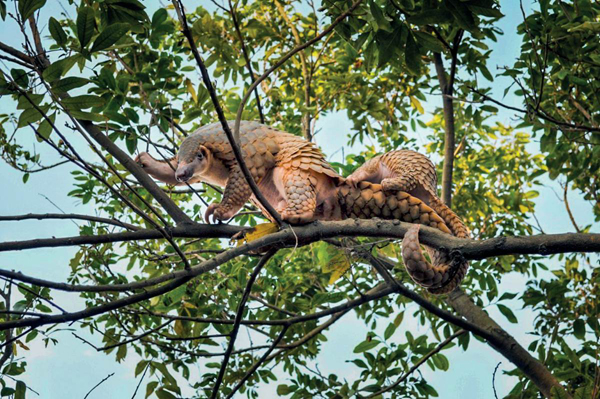Manis crassicaudata
IUCN
LCBasic Information
Scientific classification
- name:Manis crassicaudata
- Scientific Name:Manis crassicaudata,Thick-tailed pangolin, scaly anteater
- Outline:Pangolins
- Family:Pholidota Pangolinidae G.Pangolin
Vital signs
- length:78-120cm
- Weight:4.7-9.5kg
- lifetime:7-9years
Feature
The head is small and triangular, and the body is slender and long.
Distribution and Habitat
In China, it is mainly distributed in southwestern Yunnan. Abroad, it is distributed in India, Nepal, Pakistan and Sri Lanka.
This strange scaly mammal occupies grasslands, rainforests and barren hilly areas. It can also survive in modified habitats if there are a large number of termites and ants.
Appearance
No teeth. Head and body length is 45-75cm, tail length is 33-45cm. Weight is 4.7-9.5kg. Males are usually larger than females. The head is small and triangular, and the tongue is 23-25.5cm long. The external ears are small. The body is slender and long. The dorsal side is covered with 15-18 rows of scales, and the tail is covered with 14-16 rows of scales. The scales are yellow-brown or yellow-gray, fused with hair. The scales account for 1/4 to 1/3 of the body weight. The ventral surface from the lower forehead to the base of the tail and the inner side of the limbs has no scales, and is covered with sparse hair. There are 5 toes, of which the second, third and fourth toes have long claws. The bottom of the tail tip is also covered with scales. The anal gland secretes a foul-smelling yellow liquid.
Details
Although it is a ground-dwelling animal, it is good at climbing using its prehensile tail. It lives alone most of the time, except during the mating season. It mainly feeds on ants and termites. It spends most of its time in caves or rocks. When frightened, it curls up into a ball. It usually gives birth to one (sometimes two) pups per litter. Due to the illegal wildlife trade, the Indian pangolin is in rapid decline and is rarely seen in the wild.
The Indian pangolin is very similar to the pangolin, but is larger than the pangolin. It differs from the pangolin in that it has less obvious external ears, scales on the ventral side of the tail tip, and no groove in front of the anus. Other descriptions are the same.
To protect itself, the Indian pangolin curls up into a ball, leaving only its scales exposed. They also have anal glands that emit a foul-smelling yellow fluid to defend against their predators.
The Indian pangolins found in Sri Lanka live in tropical rainforests, where most ants eat fruits and flowers from trees. Here, the pangolins make full use of their prehensile tails and sharp claws to live in an arboreal environment. They climb with their forelimbs and use their tails and limbs for better coordination. Since most of the Indian pangolins’ food lives on the ground, they are also considered terrestrial creatures.
The Indian pangolin is an anteater. They mainly eat termites, ants and their eggs. There have also been reports of Indian pangolins with stomachs full of beetle elytra, cockroaches and worm skins.
Indian pangolins do not have good hearing or vision, they rely on their sense of smell to locate ant and termite nests. The species has 3 main claws that can dig into hard soil. Once they find an exposed nest, they use their long tongue to easily infiltrate the nest. They quickly "lick" their tongue along the nest, as if trying to catch prey with a drink. Since Indian pangolins have no teeth, the "chewing" process is all done in the stomach. Indian pangolins have two stomachs, one for storage and the other stomach is only 1/5 of the size. This part is lined with thick muscle tissue and is used to digest rough food, "chewing" and grinding food before it enters the intestines.
Listed in China's "National Key Protected Wildlife List" (February 5, 2021) Level 1.
Legend:
There is a story about a villager and a pangolin in India. A villager was knocked down by a pangolin and he brought the pangolin back to the village. The pangolin sensed that the situation was not good and soon tried to curl up into a ball. Unfortunately, the villager's neck was caught in the middle until he was found strangled to death with the pangolin still wrapped around him.




